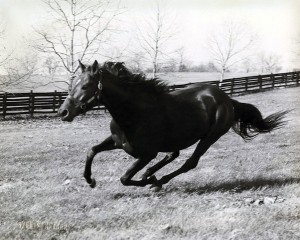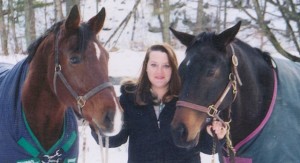Kim Gatto is on a roll! A year after penning a book on the Saratoga Race Course, she has released a new work capturing the excitement of America’s once preeminent stud farm, Belair.
In this week’s Reader’s Clubhouse, Gatto talks about her new book, Belair Stud: The Cradle of Maryland Horse Racing, the famous horses contained within its pages, and hints at future projects.
Q: Belair Stud follows closely on the heels of Saratoga Race Course: The August Place to Be. Both books are thoroughly researched histories that sparkle with excitement. Kim, have you found a new niche for yourself? Do you plan to chronicle any other racetracks of breeding farms?
Yes, I actually have been asked to write a book on the history of Belmont Park, so I will begin that one soon!
Q: How did you choose Belair Stud as a topic?
The topic came up while I was doing research for my books on Churchill Downs and Saratoga. I was amazed at the accomplishments of Belair, which remains the only farm to have produced father-son Triple Crown winners (Gallant Fox and Omaha) and won an astounding number of stakes races in the 1930s through 1950s. When I began reading about the Woodwards (William, Sr. and his son, Billy) and their various champion horses, I was completely intrigued. The early history was similarly fascinating, as Belair was the first farm to import English thoroughbreds into Maryland in the 1700s. The Belair mare, Selima, is one of the foundation mares of the breed.
Q: You dedicate the book in loving memory to your first Thoroughbred, Chutney, who was the granddaughter to Belair’s famous racer, Nashua. Do you think your longtime friendship with Chutney influenced you in your choice of book topics?
Yes, definitely. Chutney bore a very strong physical resemblance to Nashua, so of course, I developed an interest in him. I tried to be objective, but he is definitely my favorite! He had a profound impact on the sport, both on the racetrack and in the breeding shed. Incidentally, when I sent the book to Chutney’s previous owner, she thought that the photo of Nashua playing in the field looked exactly like Chut. Both were very strong and athletic while remaining elegant and noble. Also, both had very strong and feisty, yet kind, temperaments.
Q: What is your hope for this type of race-history book? Do you hope to influence a new crop of racing enthusiasts?
I hope so. Since its closure, I feel that Belair has been somewhat forgotten, and my goal is to educate more people about its immense contributions to our sport. I also hope that more folks will visit the Belair Stable Museum in Bowie, Maryland and support its efforts to preserve this great history.
Q: Belair started in the days of yore, on three parcels of land. In its heyday, how big, how influential did this stud farm become?
In addition to breeding champion racehorses, Belair was a full working farm, complete with sheep and cattle, spanning over a thousand acres. Mr. Woodward, Sr. also bred prized Clydesdales, some of which were sold to Anheuser Busch and to the circus. An interesting story is that Mr. Woodward lent a flock of sheep to President Woodrow Wilson in 1918 to help defray the costs of landscaping during the war. The sheep grazed on the White House lawn. When the sheep were shorn, the wool was auctioned off for charity.
Q: What was its more crowning achievement, so to speak?
I would say the fact that they produced father-son Triple Crown winners, plus Nashua, along with four English classic winners, and a huge amount of stakes winners within a relatively short period of time. Belair won three Kentucky Derbies, three Preakness Stakes, and six Belmont Stakes, just to name a few. There are five Belair horses in the Hall of Fame. Mr. Woodward, Sr.’s dream was to win the Epsom Derby, and while he fell just shy of that goal (by a nose), he achieved an amazing amount of success. He was also a very interesting person – a Harvard-educated attorney who also penned at least two books: one on Gallant Fox and another on the life of his longtime friend and employee, a former slave by the name of Andrew Jackson.
Q: And, what differentiates Belair from other successful stud farms?
I was impressed by the dedication that Mr. Woodward, Sr. displayed in his research of bloodlines. He was meticulous in his research, and spent a few years in England (as secretary to the United States ambassador) during which he took every opportunity to study racing bloodlines. It was important to him to produce horses with the substance and stamina to win distance races. In fact, he had bred Nashua with the hopes of racing him in England. However, Mr. Woodward died while Nashua was a yearling, and his son, Billy, opted to keep Nashua in the U.S.
Q: Chapter 12: Triumph and Tragedy, covers a lot of ground! There’s the match race of Nashua and Swaps, and then the tragic shooting death of Belair’s 35-year-old master of the farm. In researching this part of the story, was there any new information?
I worked closely with Pam Williams and Russ Davies, the directors of the Belair Stable Museum, to ensure that everything was correct in the manuscript. We agreed to focus more on Billy Woodward’s contribution to the sport than on his tragic death. There have been books, films, and documentaries that speculate about his death and the events leading up to it, so I decided to focus more on Billy’s relationship to Nashua and how much he helped our sport in a short period of time. In fact, at the time of his death, Billy had been selected by Sports Illustrated as its Sportsman of the Year, which was an incredible honor. One of the things about Billy that continues to impress me is that, in footage of him leading Nashua, he was always petting the horse. Both he and his father were genuine horsemen who cared deeply about their animals, and that shines through in photos and on film. Billy also was very kind to the fans. On one occasion, there was speculation that Nashua would be scratched from a race due to a rainstorm. After seeing all of the fans who had gathered to cheer Nashua on, Billy said he did not want to disappoint the fans by withdrawing from the race. (Of course, he first made sure that the footing was safe for the horse!)
Q: How did this tragedy affect the farm?
It resulted in the closure of the farm and the sale of all of the horses, including Nashua. He was sold to a syndicate led by Leslie Combs II of Spendthrift Farm, who raced him for one more season. After that, he stood at Spendthrift for many years, ultimately siring 77 stakes winners. He lived to be 30 years old. Nashua’s bloodlines live on in the champions of today, ranging from Rachel Alexandra and Zenyatta to Union Rags and Havre de Grace.
Sadly, at the time of his death, Billy had great plans for Belair. He had planned to return it to a full working farm and had purchased a custom airplane so that he could visit the farm on a frequent basis. The farm was sold to a developer, and now only a small amount of the land remains undeveloped. The mansion and part of the stable are now a museum that belongs to the town of Bowie. The museum houses many artifacts, including the Belair silks, Nashua’s racing plates, some of Mr. Woodward’s journals and art collection, and many other items. It allows visitors to step back into the “glory days.” Nashua’s stall, along with those of Gallant Fox and Omaha, have also been preserved.






hi susan
please excuse my typing………..i just broke my wrist
congratulations on a 5 star interview…….as you know, i was so fortunate to photograph some of the photos in kim’s latest book………i was lucky to get to visit the belair mansion and the stable that kept nashua, gallant fox, and omaha…. …..i was so anxious for kim’s book to come out, because now, i was intrigued with the history of the mansion, the woodwards, and of course nashua…..finally, i received my book…….congratulations kim,it is so beautifully written, with so much information and so entertaining, as well.
thank you susan, great interview…..
Great interview!! Very informative. I love the fact that the author of the book is so focused on the book and the book’s subject. Tells me it’s going to be a great read!
Great interview!
As Manager of Historic Properties for the City of Bowie, Md., I – and colleague Russ Davies, Stable Museum Manager, worked with Kim on her wonderful new book. We are delighted with her product – a wonderful story about a wonderful place. As we head into the Triple Crown Campaign season, we always pause and remember how many of Belair’s incredible horses were part of that series. Kim’s book commits our story to history for all to enjoy. We are proud to have helped in this effort!
Please visit…the Belair Stable is located at 2835 Belair Drive, Bowie Md., and is open Tues.thru Sun., noon-4. Free Admission.
Congratulations to Kim…and our thanks to her for this wonderful book!!!!!!